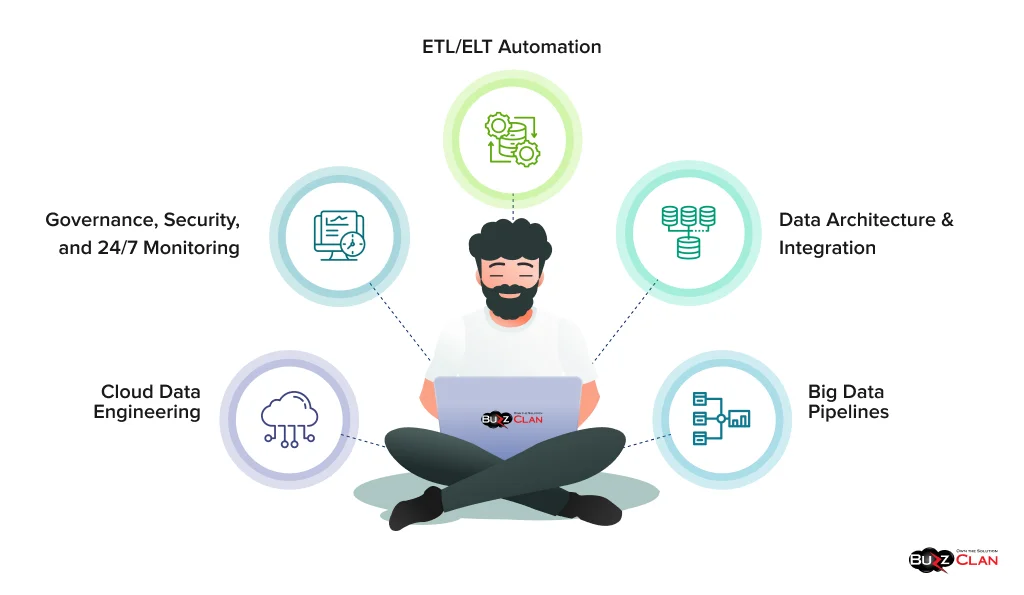Designing Data Pipelines That Don’t Break Under Pressure
Deepak Desai
Jul 31, 2025
When data pipelines break, it’s not just a technical issue—it’s a business risk hiding in plain sight.
Research shows that 98% of organizations report losses exceeding $100,000 for just one hour of downtime. Some lose up to $9,000 every minute.
However, the impact goes far deeper than lost revenue, broken pipelines cause:
- Data Loss
- Delayed Insights
- Poor Decision-Making
- Eroded Trust
- Slowed Innovation
Too many organizations focus on quick fixes instead of addressing the root causes. As data becomes more integral to product delivery and decision-making, these challenges only grow more complex and costly.
In this blog post, we’ll look at the key pressures that impact data pipelines and explore the most common reasons they fail. You’ll also learn proven design and testing strategies to build scalable, resilient pipelines that keep your operations running smoothly.
Why Data Pipelines Fail Under Pressure
Data pipelines are the digital arteries of your organization. When well-architected, they deliver timely and reliable insights that drive confident decisions. But under pressure, even well-designed pipelines can slow down—or worse, fail.
So, where does that pressure come from?
This stress comes from multiple directions:
- Data Volume & Velocity: As organizations grow, so does the amount and speed of data. Without the right architecture in place, pipelines can quickly become bottlenecks instead of enablers.
- Data Source Diversity: From relational databases to APIs and SaaS tools, integrating various formats introduces schema mismatches and format inconsistencies.
- Real-Time Demand: Business functions, such as dashboards, fraud detection, and customer personalization, depend on low-latency data. Traditional batch processing often can’t keep up.
- Data Quality Issues: Inaccurate, incomplete, or inconsistent data compromises insights at the source, eroding trust and leading to flawed decisions downstream.
- Security & Compliance: Regulations such as GDPR and HIPAA require data privacy, lineage, and resilience, adding pressure to design choices.
- Rising Costs & Skill Gaps: Inefficient pipelines and limited in-house expertise drive up cloud costs and create operational bottlenecks.
These pressures don’t show up in isolation. They compound over time. The more they build up, the harder it becomes to scale, optimize, or even maintain pipeline performance. Teams often shift into reactive mode, constantly fixing issues instead of improving outcomes.
Want to ease pipeline pressure without a full rebuild?
Data virtualization gives you real-time access without duplicating data or straining source systems.
So, how do you build pipelines that won’t break under pressure?
Well, it starts with architecture and is reinforced by testing.
The Blueprint for Resilience: Data Pipeline Architecture Principles
A resilient pipeline isn’t reactionary—it’s built from the ground up with certain principles in mind. These principles form the foundation of a system that scales, adapts, and recovers under pressure:
Modularity
Break your pipeline into independent components—ingestion, transformation, output—so teams can test, deploy, and troubleshoot faster, without touching the entire system.
Scalability
Design with distributed processing and cloud-native storage to scale effortlessly as your data volume and velocity increase.
Fault Tolerance
Build for failure. Utilize replication, load balancing, and automatic failover to maintain a continuous pipeline operation even when certain components fail.
Robust Error Handling
Don’t just catch errors—contain them. Use retries, dead-letter queues, and circuit breakers to isolate issues without disrupting the flow.
Data Validation
Validate early, validate often. Detect and correct bad data at every stage to prevent downstream issues and maintain data integrity.
Observability
Enable real-time monitoring, logging, and alerting to detect issues early, optimize performance, and ensure pipeline reliability.
While these architectural principles lay the foundation for resilient pipelines, sound design alone isn’t enough—rigorous testing is essential to ensure these systems perform as intended when it matters most.
By running a data health check early, you can prioritize the right fixes and build a stronger foundation for data-driven decision-making.
Request a Free Data Health Check Now!
How Smart Teams Test Data Pipelines to Prevent Failures
Even a well-built pipeline can crumble under pressure if it’s not tested for the real world. Innovative teams don’t gamble on production—they run stress tests, simulate failures, and check for weak links upfront. It’s how they catch issues early, avoid costly downtime, and keep data flowing when the stakes are high. Thus, leading data teams incorporate multiple layers of testing:
- Unit testing verifies code logic, schemas, and transformations to catch bugs early in the development process.
- Integration tests check that pipeline components interact and transfer data correctly as a unified system.
- End-to-end tests ensure the entire pipeline flows successfully from the data source to the final destination using real data.
- Data quality tests validate the accuracy, completeness, and consistency of data to prevent poor data from entering production systems.
- Performance tests measure throughput, load handling, and latency to confirm the pipeline meets SLAs and is ready to scale.
From Theory to Practice: What Resilient Pipelines Look Like in the Real World
Here’s how leading organizations built resilient data pipelines that scaled, recovered, and delivered results even under pressure.
Financial Services
A global firm modernized its fragmented pipeline using Azure Data Factory and Databricks, enabling automated ingestion and real-time ML analytics. This resulted in a scalable, high-performance infrastructure that delivered faster insights across the business. Learn more about it here.
Healthcare Provider
Burdened by manual processes and security risks, a healthcare giant (with 260+ clients) implemented ETL automation, secure file transfers, and a modern Data Lake. They cut manual effort by 40% and eliminated data breaches, boosting operational security and efficiency. Click here to know the story in depth.
Retail Leader
A luxury retailer facing messaging fatigue turned to AI-driven pipelines for smarter customer segmentation and dynamic content routing. With better targeting and reduced noise, engagement rose by 47%, message fatigue dropped by 35%, and campaign ROI tripled.
How BuzzClan Can Help You Build Pipelines That Last
From architecture to automation, our full-stack data engineering services help you move faster, stay accurate, and be in control.
Here’s how we do it:

- Data Architecture & Integration: Bring all your data together, cleanly and clearly.
- Big Data Pipelines: Real-time and batch processing with Spark, Hadoop & Flink.
- Cloud Data Engineering: Optimize for AWS, Azure, or GCP.
- ETL/ELT Automation: Smarter pipelines with validation, lineage, and CI/CD.
- Governance, Security, and 24/7 Monitoring: Ensuring Compliance, Protection, and Continuous Pipeline Uptime.
Conclusion: Your Path to Unbreakable Data Flow
The real risk isn’t when pipelines break loudly—it’s when they fail silently, slipping under the radar until it’s too late. That’s why the strongest systems aren’t just functional—they’re resilient by design.
The businesses that thrive tomorrow are already building for adaptability today.
They validate early, monitor continuously, and recover quickly—because they know every delay, every bottleneck, every broken insight costs more than just time.
FAQs

Get In Touch
Follow Us
Table of Contents
- Why Data Pipelines Fail Under Pressure
- The Blueprint for Resilience: Data Pipeline Architecture Principles
- How Smart Teams Test Data Pipelines to Prevent Failures
- From Theory to Practice: What Resilient Pipelines Look Like in the Real World
- How BuzzClan Can Help You Build Pipelines That Last
- Conclusion: Your Path to Unbreakable Data Flow
- FAQs
- Get In Touch